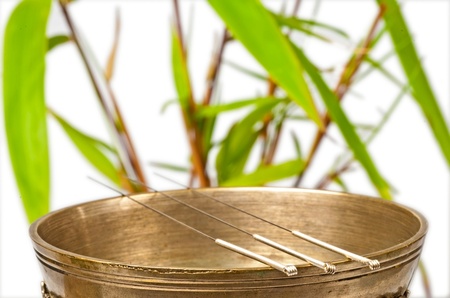What is acupuncture?

Acupuncture is an ancient medical practice that forms part of Chinese medicine.
Acupuncture promotes the flow of the ancient Chinese concept of "vital energy" (known as 'Qi' and pronounced as "chi"). In Chinese medicine this proper flow of Qi is essential for a good health and imbalances in its flow, quality and strength are seen as the causes of poor health.
The meaning of the concept of Qi remains obscure in significance but could be explain as the order and harmony of a state of health, or homeostasis.
It is applied by inserting fine sterile needles into the skin which are retained for about 20 to 30 minutes. After a session its common to experience a feeling of relaxation and well being.
It can be applied to people of all ages and backgrounds. Since the past couple of decades it's popularity and use have increased dramatically worldwide.
During an acupuncture session it's normal to add other treatment strategies such as suction cups (cupping) and moxibustion. Sometimes the effects of acupuncture and the way it's applied can be altered to suit a problem more properly, and usually electro acupuncture and auricular (ear) acupuncture are chosen for this.
The application of suction cups (cupping) and Moxibustion (a therapy that applies heat directly to acu-points) are usually combined as part of an acupuncture session.
Acupuncture promotes the flow of the ancient Chinese concept of "vital energy" (known as 'Qi' and pronounced as "chi"). In Chinese medicine this proper flow of Qi is essential for a good health and imbalances in its flow, quality and strength are seen as the causes of poor health.
The meaning of the concept of Qi remains obscure in significance but could be explain as the order and harmony of a state of health, or homeostasis.
It is applied by inserting fine sterile needles into the skin which are retained for about 20 to 30 minutes. After a session its common to experience a feeling of relaxation and well being.
It can be applied to people of all ages and backgrounds. Since the past couple of decades it's popularity and use have increased dramatically worldwide.
During an acupuncture session it's normal to add other treatment strategies such as suction cups (cupping) and moxibustion. Sometimes the effects of acupuncture and the way it's applied can be altered to suit a problem more properly, and usually electro acupuncture and auricular (ear) acupuncture are chosen for this.
The application of suction cups (cupping) and Moxibustion (a therapy that applies heat directly to acu-points) are usually combined as part of an acupuncture session.
What is an acupuncturist?
An acupuncturist is an individual who uses acupuncture in their Chinese Medicine practice. Currently the "Acupuncturist" title is protected under national law in Australia and is reserved only to those that are registered as such. However, the "Acupuncture" title is not protected and any person can claim to do Acupuncture, in spite of not being registered as an Acupuncturist. Always ask the practitioner providing acupuncture if they're trained as an acupuncturist, otherwise you can report them to AHPRA for holding out.
What to look for in an acupuncturist
Usually the most important thing is to make sure that the person claiming to be an acupuncturist or applying acupuncture has a license to do so.
Since July 2012 the practice of Chinese medicine which includes acupuncture and Chinese herbal medicine became nationally registered under the Australian Health Practitioner Register Association (AHPRA). This means that a license is required for any person practicing Chinese medicine and the minimum requirement is to hold a Bachelor's degree in Chinese medicine (Health Sciences). This decision was made in order to protect the public and to ensure a safe and regulated practice.
There are other practices that insert needles as part of their treatment repertoire but this is not necessarily acupuncture. The most common of this is "dry needling" which as therapy that uses needle insertion for the treatment of muscular pain. There is a big difference with acupuncture in the sense that acupuncture is a complete medical practice use for many ailments, including pain. Also, dry needling training can range from one to two days or a couple of weeks, where as acupuncturists need to train for a minimum of four years.
If you're not sure, always ask your health practitioner about their qualifications and licenses. Any ethical health practitioner should always be able to tell you what they are practicing.
Since July 2012 the practice of Chinese medicine which includes acupuncture and Chinese herbal medicine became nationally registered under the Australian Health Practitioner Register Association (AHPRA). This means that a license is required for any person practicing Chinese medicine and the minimum requirement is to hold a Bachelor's degree in Chinese medicine (Health Sciences). This decision was made in order to protect the public and to ensure a safe and regulated practice.
There are other practices that insert needles as part of their treatment repertoire but this is not necessarily acupuncture. The most common of this is "dry needling" which as therapy that uses needle insertion for the treatment of muscular pain. There is a big difference with acupuncture in the sense that acupuncture is a complete medical practice use for many ailments, including pain. Also, dry needling training can range from one to two days or a couple of weeks, where as acupuncturists need to train for a minimum of four years.
If you're not sure, always ask your health practitioner about their qualifications and licenses. Any ethical health practitioner should always be able to tell you what they are practicing.